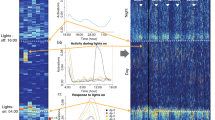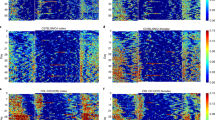Abstract
The loomotor activity of male mice (Mus musculus) was monitored by infrared photoelectric beams under three lighting regimens: LD (12 h of light and 12 h of dark), DD (constant dark), and LL (constant broad-spectrum light, 10 lux). Circadian period of locomotor activioty (τ) was compared among 3 inbred strains of mice, C57BL/6J (B6), BALB/c (C), and DBA/2J (D2), and 26 recombinant inbred strains B×D (B6×D2). the τ under both continuous low-intensity light and continuous darkenss varied significantly among strains. Under DD the mean τ was 23.8 h for B6, 23.7 h for D2, and 23.6 h for C. Under LL the mean τ was 25.1 for B6, 23.9 h for D2, and 25.5 h for C. Frequency histograms of the mean τ of 26B×D RI mouse strains (three to seven animals per strain) in either DD or LL and the difference between them, Δτ, had distributions which appeared unimodal, suggesting polygenic inheritances. The narrow-sense heritability determined using 26 strains of B×D RI mice was about 55% for τ and about 38% for both τ in LL and Δτ. An estimated four loci contribute to the variance of τ in constant darkness and five to the variance of τ in constant low-intensity light among the strains studied. Quantitative trait locus (QTL) analysis identified several potential genetic loci associated with τ in constant darkness, τ in constant low-intensity light, and Δτ. The associations of highest probability for each of these traits were theD1Nds4 locus (p<0.001) on mouse chromosome 1, theD5Ncvs52 locus (p<.05) on mouse chromosome 5, and thePmv12 locus (p<.01) at 70 cM on mouse chromosome 5, respectively. A QTL identified for τ was associated (p<.05) with theD2NDS1 marker at 45 cM on chromsome 2 near the Ea 6 marker at 46 cM associated (p<.05) with that reported for the period of wheel running activity in seven C×B RI strains (Schwartz, W. J., and Zimmerman, P.,J. Neurosci. 10:3685 1990).
Similar content being viewed by others
References
Abe, H., Kida, M., Tsuji, K.,et al. (1989). Feeding cycles entrain circadian rhythms of locomotor activity in CS mice but not in C57BL/6J mice.Phys. Behav. 45:397–401.
Aschoff, J. (1960). Exogenous and endogenous components in circadian rhythms.Cold Spring Harbo Symp. Quant. Biol. 25:11–28.
Aschoff, J. (1979). Circadian rhythms: Influence of internal and external factors on the period measured in constant conditions.Z. Tierpsychol. 49:225–249.
Aschoff, J., Figala, J., and Poppel, E. (1973). Circadian rhythms of locomotor activioty in the golden hamste (Mesocricetus auratus) measured with two different techniques.J. Comp. Physiol. Phychol. 85:20–28.
Bailey, D. (1981). Recombinant inbred strains and bilineal congenic strains. In Foster, H., Snall, J. D., and Fox, J. (eds.),The Mouse in Biomedical Research, Vol. 1, Academic Press, New York, pp. 223–239.
Beau, J. (1986). Components comparison of activity rhythm in three inbred mice strains. In Medoni, J., and Vaysse, G. (eds.),Genetic Approaches to Behavior, Privat IEC, Toulouse, pp. 19–27.
Beau, J. (1991). Activity rhythms in inbred mice. I. Genetic analysis with recombinant inbred strains.Behav. Genet. 21:117–129.
Belknap, J. K. (1992). Empirial estimates of Bonferroni estimates of Bonferroni corrections for use in chromosome mapping studies with the B×D recombinat inbre strains.Behav. Genet. 22:677–684.
Belknap, J. K., Metten, P., Helms, M. L., O'Toole, L. A., Angeli-Gade, S., Crabbe, J. C., and Phillips, T. J. (1993). Quantitative trait loci (QTL) applicatios to substances of abuse: Physical dependence studies with nitrous oxide and ethanol in B×D mice.Behav. Genet. 23:2313–222.
Connolly, M. S. and Lynch, C. B. (1983). Classical genetic analysis of circadian body temperature rhythms in mice.Behav. Genet. 13:491–500.
Crabbe, J. C., Kosobud, A., Young, E. R., and Janowsky, J. S. (1983). Polygenic and single gene determination of responses to ethanol in B×D/Ty recombinat inbred mouse strains.Neurobehav. Toxicol. Teratol. 5:181–187.
Daan, S., and Pittendrigh, C. S. (1976). A functional analysis of circadian pacemakers in nocturnal rodents. III. Heavy water and constant light: homeostasis of frequency.J. Comp. Physiol. 106:267–290.
Dietrich, W., Katz, H., Lincoln, S. E., Shin, H. S., Friedman, J., Dracopoli, N. C., and Lander, E. S. (1992). A genetic map of the mouse suitable for typing intraspeific crosses.Genetics 131:423–447.
Ebihara, S., and Tsuji, K. (1976). Strain difference in the mouse's wheel-running behavior.Jpn. J. Psychol. Res. 18:20–29.
Ebihara, S., Tsuji, K., and Kondo, K. (1978). Strain differences in the mouse's free-running circadian rhythm in continuous darkness.Physiol. Behav. 20:795–799.
Edgar, D. M., Martin, C. E., and Dement, W. C. (1991). Activity feedback to the mammalian circadian pacemaker: Influence on observed measures of rhythm period length.J. Biol. Rhythms 6:185–199.
Gora-Maslak, G., McClearn, G., Crabbe, J. C., Phillips, T., Belknap, J., and Plomin, R. (1991). Use of recombinant pharmacology.Psychopharmacology 104:413–424.
Hegmann, J. P., and Possidente, B. (1981). Estimating genetic correlations from inbred strains.Behav. Genet. 11:103–114.
Johnston, T. E., DeFries, J. C., and Markel, P. D. (1992). Mapping quantitative trait loci for behavioral traits in the mouse.Behav. Genet. 22:635–653.
Kornhauser, J. M., Nelson, D. E., Mayo, K. E., and Takahashi, J. S. (1992). Regulation of jun-B messenger RNA and AP-1 activity by light and a circadian clock.Science 255:1581–1584.
Kornhauser, J. M., Mayo, K. E., and Takahashi, J. S. (1993). Immediate-early gene expression in a mammalian circadian pacemaker: The suprachiasmatic nucleus. In Young, M. (ed.),Molecular Genetics of Biological Rhythms, Marcel-Dekker, New York, pp. 271–307.
Lander, E., and Botstein, D. (1989). Mapping mendelian factors underlying quantitative traits using RFLP linkage maps.Genetics 121:185–199.
Lyon, M. F., and Kirby, M. C. (1994). Mouse chromosome atlas.Mouse Genome 92:19–61.
Maltais, L. J., Doolittle, B. P., Roderick, T. H., Hillyard, A. L., and Davisson, M. T. (1994). Locus map of mouse.Mamma. Genome 92:62–85.
Manly, K. F. (1993). A Macintosh program for storage and analysis of experimental genetic mapping data.Mamm. Genome 4:303–313.
McClearn, G. E., Plomin, R., an Gora-Maslak, G. (1991). The gene chase in behavioral science.Psychol. Sci. 2:222–229.
McNemar, Q. (1962).Psychological Statistics, 3rd ed., Wiley, New York.
Meijer, J. H. (1990). Physiological basis for photic entrianmen.Eur. J. Morphol. 28:308–316.
Mrosovsky, N. (1989) Nonphotic enhancement of adjustment to new light-dark cycles: Masking interpretation discounted.J. Biol. Rhythms 4:365–370.
Neumann, P. E., and Collins, R. L. (1991). Genetic dissection of susceptibility to audiogenic seizures in inbred mice.Proc. Natl. Acad. Sci. USA 88:5408–5412.
Neumann, P. E., and Seyfried, T. N. (1990). Mapping of two genes that influence susceptibility to audiogenic seizures in crosses of C57BL/6J and DBA/2J mice.Behav. Genet. 20:307–323.
Oliverio, A., and Malorni, W. (1979). Wheel-running and sleep in two strains of mice: Plasticity and rigidity in the expression of circadian rhythmicity.Brain Res. 163:121–133.
Peleg, L., Nesbitt, M. N., and Ashkenzazi, I. E. (1989). Strain depenent response of circadian rhythms during exposure to constant illumination.Life Sci. 44:893–900.
Pickard, G. E., and Sollars, P. J., and Rinchik, E. M. (1994). Mutagenesis screen identifies a mouse (187) with alteed circadian rhythms.Soc. Res. Biol. Rhythms Abstr. 58.
Pittendrigh, C. S., and Daan, S. (1976). A functional analysis of circadian pacemakers in nocturnal rodents. I. The stability and lability of spontaneous frequency.J. Comp. Physiol. 106:223–252.
Possidente, B., and Hegmann, J. P. (1980). Circadian complexes: Circadian rhythms under common gene control.J. Comp. Physiol. 139:121–125.
Possidente, B., and Hegmann, J. P. (1980). Gene differences modify Aschoff's rule in mice.Physiol. Behav. 28:199–200.
Possidente, B., and Stephan, K. (1988). Circadian period in mice: Analysis of genetic and maternal contributions to inbred strain differences.Behav. Genet. 18:109–117.
Possidente, B., Hegmann, J. P., Carlson, L., and Elder, B. (1982). Pigment mutations associated with alterled circadian rhythms in mice.Physiol. Behav. 28:389–392.
Ralph, M. R., and Menaker, M. (1988). A mutation of the circadian system in golden hamsters.Science 241:1225–1227.
Rea, M. A. (1989). Light increases For-related protein immunoreactivity in the rat suprachiasmatic nuclei.Brain Res. Bul. 23:577–581.
Rosbash, M., and Hall, J. C. (1989). The molecular biology of circadian rhythms.Neuron 3:387–398.
Schwartz, W. J., and Zimmerman, P. (1980). Circadian timekeeping in BALB/c and C57BL/6 inbred mouse strains.J. Neurosci. 10:3685–3694.
Seyfried, T. N., Yu, R., and Glaser, G. H. (1980). Genetic analysis of audiogenic seizure susceptibility in C57/BL/6J×DBA/2J recombinant inbred inbred strains of mice.Genetics 994:701–718.
Silver, I. M., Nadeau, J. H., and Goodfellow, P. N. (1993). Encyclopedia of the mouse genome. III.Mamm. Genome 4:S1-S283.
Takahashi, J. S., Pinto, L. H., and Vitaterna M. H. (1994). Forward and reverse genetic approaches to behavior in the mouse.Science 264:1724–1733.
Taylor, B. A. (1990). Recombinant inbred strains. In Lyon, M. F., and Scarle, A. G. (eds.),Genetic Variants and Strains of the Laboratory Mouse, Oxford University Press, Oxford, pp. 773–796.
Vitaterna, M. H., King, D. P., Chang, A.-M., Kornhauser, J. M., Lowrey, P. L., McDonald, J. D.., Dove, W. F., Pinto, L. H., Turek, F. W., and Takahashi, J. S. (1994). Mutagenesis and mapping of a mouse gene clock essential for circadian behavior.Science,264:719–725.
Vitaterna, M. H., Lowrey, P. L., McDonald, J. D., Dove, W. F., Pinto, L. H., Turek, F. W., and Takahashi, J. S. (1993). Isolation of the first circadian clock mutation in the mouse.Soc. Neurosci. Abs. 19:610. 10.
Author information
Authors and Affiliations
Corresponding author
Rights and permissions
About this article
Cite this article
Hofstetter, J.R., Mayeda, A.R., Possidente, B. et al. Quantitative trait loci (QTL) for circadian rhythms of locomotor activity in mice. Behav Genet 25, 545–556 (1995). https://doi.org/10.1007/BF02327578
Received:
Accepted:
Issue Date:
DOI: https://doi.org/10.1007/BF02327578




